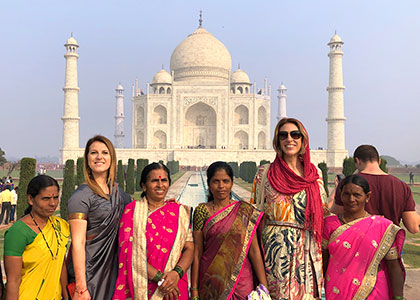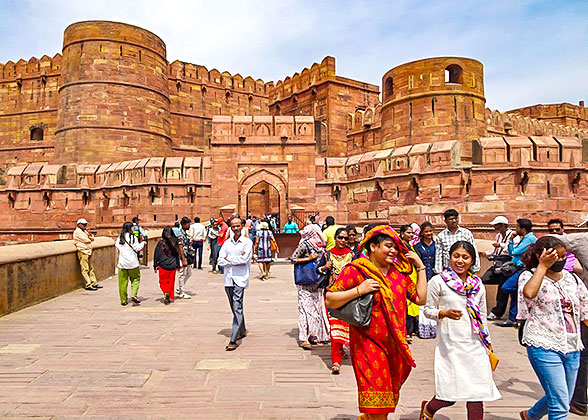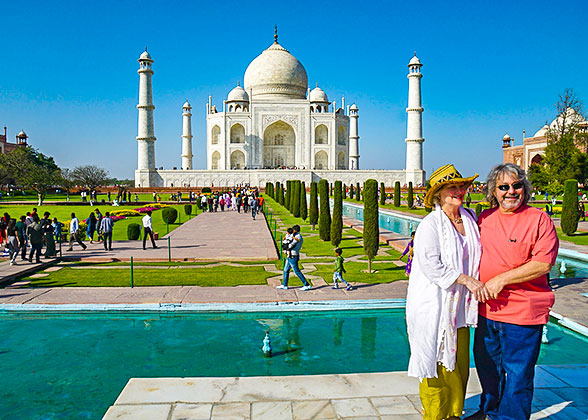Agra Attractions
Once the capital of the Mughal Empire and now a stop of the classic “India Golden Triangle” tour, Agra is a popular tourist destination where travelers will find three World Heritage sites – Taj Mahal, Agra Fort and the Fatehpur Sikri town. In addition, a lot of fascinating Mughal-era mausoleums, ancient mosques, and bustling markets are worth exploring during a Agra trip. The Mughal Empire’s legacy makes Agra one of the most attractive cities in India and travelers are advised to spend 2-3 days in experiencing the charm of Agra.Top Attractions
1. Taj Mahal

Taj Mahal
|
2. Agra Fort
Inscribed as one of UNESCO's World Heritage Sites in 1983, Agra Fort is an awe-inspiring military fortress mostly made of red sandstone. Once the erstwhile residence of the Mughals, the historic fort is the symbolism of bravery, resilience, and pride. The walls of Agra Fort are 70-feet high and the perimeter of the walls is around 2 kilometers (1.2 miles). With a magnificent appearance, the huge structure contains hundreds of palaces, halls, towers, gardens and mosques, such as Khas Mahal, Jahangir Mahal and Musamman Burj which are all decorated with stone carvings and fine mosaics.3. Fatehpur Sikri

Fatehpur Sikri, Agra
|
4. Mehtab Bagh
The crescent-shaped Mehtab Bagh or the Moonlight Garden, is one of the last Mughal gardens, located on the bank of the Yamuna River, just facing the Taj Mahal. Because of the superior location, Mehtab Bagh provides a perfect spot for tourists to enjoy the gorgeous sunset of Taj Mahal away from the crowd. This garden was originally designed in four sections and had the lanes of white walkways, large fountains and spacious pavilions filled with colorful fruit trees. However, it was reduced to a huge mound of sand by frequent floods. The Mehtab Bagh we see now is restored by planting hibiscus, guava, and citrus trees to make it look like how it was during its splendid time.5. Akbar’s Tomb
The Tomb of Akbar the Great is one of the Mughal architectural masterpieces. Akbar the Great, the third emperor of the Mughal dynasty from 1556 to 1605 AD, started the construction of this edifice, which was later completed by his son Jahangir. Akbar’s Tomb is the perfect example of the assimilation of various styles of architecture that representing the culture and history of the Mughals in India. Settled in a large walled garden, the mausoleum is surely imposing and ravishing, with floral-design embellishments, colored marbles and four white minarets. If lucky enough, you may see deer grazing quietly in this scenic area.More Tourist Attractions in Agra
1. Buland Darwaza, also known as Gate of Victory, is an opulent structure built to commemorate Akbar’s victory over Gujarat. Entering from the southern entrance Fatehpur Sikri, you are first greeted by the magnificent towering gateway. Built from red sandstone and decorated with white and black marbles, the building is 54 meters (177 feet) high, making it one of the tallest gateways in the world.2. Jama Masjid was commissioned by Shah Jahan in 1648 AD in dedication to his daughter Jahan Ara Begum. The mosque is made of white marble and red sandstone in a unique blend of Hindu and Muslim architecture.
3. Panch Mahal was an important part of the Fatehpur Sikri, used for entertainment and recreational purposes. Resembling a Buddhist temple, Panch Mahal has multiple levels that decrease in size from bottom to top, giving an asymmetrical look to this five-storey palace. The entire structure contains 176 columns, which were used to hang delicate screens that skillfully hide the women from the public.
4. Tomb of Salim Chisti, located on the central courtyard of the Jama Masjid, is probably one of the finest examples of Indo-Persian architecture. The white marble structure is decorated with stunning latticework and colorful mosaic. Inside it, lies the wooden canopy made from sandalwood and adorned with mother-of-pearl shells.
5. Tomb of I'timād-Ud-Daulah, known as the “Mini Version of Taj Mahal” and Baby Taj, is a mausoleum of a Persian merchant, who was a significant part of the Mughal’s court. Constructed in a garden with four minarets at the eastern bank of the Yamuna River, the Tomb of I'timād-Ud-Daulah is made of marble, instead of sandstone which is used in most Mughal monuments.
6. Yamuna River is the largest tributary river in India, originating from the Yamunotri Glacier at a height of 20,955 feet, located at Bandarpunch. It is a sacred river for Hindus, who believe that Lord Hanuman gave birth to the river. The Yamuna River has a hot water pool at the Yamunotri, which is dedicated to the offspring of the Sun god Surya.
Read More: Wildlife Spotting in Wildlife SOS Agra Tour




